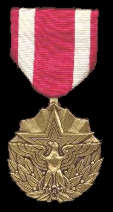
Meritorious
Service Medal
![]()

| Awarded to members of the Armed Forces of the United States who distinguish themselves by outstanding noncombat meritorious achievement or service to the United States. Normally, the acts or services rendered must be comparable to that required for the Legion of Merit, but in a duty of lesser though considerable responsibility. |
| BACKGROUND |
|
At Tri-Department Awards Conference, 5-6 February 1968, there was a discussion on the need for a third meritorious award to provide appropriate recognition for noncombat achievement or service comparable to the Bronze Star Medal for combat achievement or service. It was felt that the Legion of Meritís prestige was slipping because it was being used with increasing frequency to reward service below Legion of Merit standard, but higher than that required for the Commendation Medal. A proposed executive order was prepared in April 1968 and forwarded for approval to the Military Departments. An ad hoc committee was formed by the Secretary of Defense (M&RA) to select a name. On 8 November 1968, the committee unanimously approved the name "Meritorious Service Medal". President Johnson established the Meritorious Service Medal per Executive Order No. 11448 dated 16 January 1969. The Executive Order was amended by President Reagan per Executive Order 12312, dated 2 July 1981, to authorize award to members of the armed forces of friendly foreign nations. The ribbon design purposely follows the colors used for the Legion of Merit to reflect the parallel between the two medals. The eagle, symbol of the nation, stands on laurel branches denoting achievement. The star is used to represent the military service and the rays emanating there from denote the constant efforts of individuals to achieve through excellent and meritorious service. |